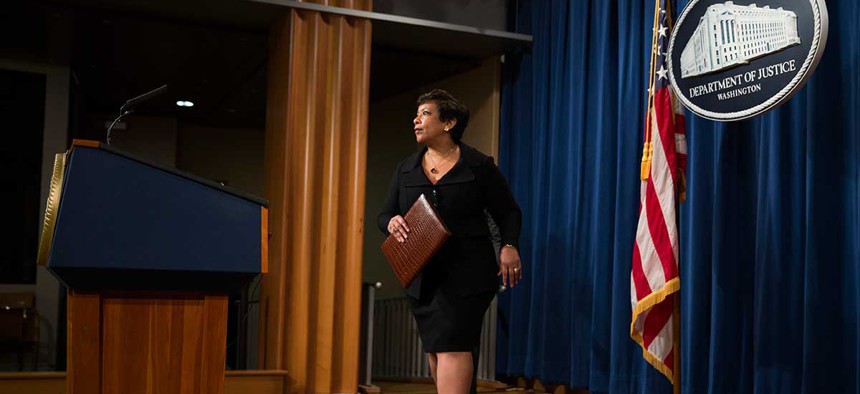
Loretta Lynch arrives at a Justice Department press conference in May. Evan Vucci/AP
The Federal Government Confronts Its Bias
A new program at the Department of Justice will train thousands of officers and attorneys on the way prejudice affects law enforcement.
Thousands of employees at the U.S. Department of Justice will now receive mandatory implicit-bias training as part of the agency’s core curriculum, the agency announced Monday. Implicit biases are unconscious invocations of stereotypes. They can be based on a person or group’s ethnicity, sex, race, or other identity factors. Often, they are subtle. But they can influence which drivers look suspicious to a police officer, who gets handcuffed during a routine stop, or how prosecutors treat people of the opposite sex, leading to discrimination.
“To some extent, implicit bias is part of human nature,” Deputy Attorney General Sally Yates wrote in a memo sent to the department earlier this week. “But implicit bias also presents unique challenges to effective law enforcement, because it can alter where investigators and prosecutors look for evidence and how they analyze it without their awareness or ability to compensate.”
This week, department heads—including leaders at the FBI, ATF, and DEA—began this training. Over the next year, more than 28,000 law-enforcement officers and attorneys will complete similar programing. According to the DOJ, the training includes a review of the most recent science on bias and how it can affect decision-making, along with “interactive sessions” in which individuals can “explore their own potential biases” in a “blame-free” setting.
Since 2010, the White House has advocated implicit-bias exercises on the local level. Police in cities like Baltimore, New Orleans, and New York have adopted such programs. But until this week, the Obama administration did not require its staffers to undergo such training. Now, in Yates’s words, the federal government is getting its “own house in order.”
Implicit bias may be impossible to entirely eliminate. But, with enough training, individuals can become aware of their prejudices and minimize the effects of those biases on their behavior. This awareness could help reduce racial disparities in who is pulled over, questioned, and arrested, and how attorneys choose to prosecute individuals.
Awareness of prejudice could quite possibly help save lives. But the efficacy of this particular training remains unclear. According to the group that designed the model on which the federal program is based, a six-hour class can prepare recruits and patrol officers to recognize and control their implicit bias. But can deeply ingrained biases, developed over decades, really be exorcised with less than one day’s work?
“People should not assume that there is anything like a silver bullet or a panacea that comes from training,” said Jerry Kang, a professor at UCLA School of Law who studies implicit bias. While he is not familiar with the particulars of DOJ’s new training curriculum, he warned that, without proper oversight, trainings can actually cause more harm than good. “There is a phenomenon that people call moral credentialing,” Kang said. “People think that because they have gone through training that they have somehow been cleansed. The real danger is someone who has gone through a poor training thinks that they’ve been essentially immunized against anything like implicit bias and, after the fact, they actually act in more discriminatory ways.”
On the other hand, proper training can make a substantial difference, according to Kang. “Good training can change someone’s mindset and induce a certain kind of humility in all of us that we are not perfect. That opens up a whole bunch of possibilities,” he said. “Suddenly a light bulb goes on and you realize, ‘Holy smokes, I might be part of the problem.’ I think changing that mindset allows people to get on the same page to try and solve problems in a useful way.”
Implicit bias training is another means by which the DOJ is hoping to alleviate the tension between law-enforcement officers and the communities they police. But implicit bias is not easy to address. By definition, it is hidden from view, cloaked behind rationalizations and split-second decision-making. This program will force some police officers and attorneys to alter how they think, work, and view the world around them. It’s a big task for anyone—whether they wear a badge or not.
NEXT STORY: The Civilians Killed in U.S. Airstrikes






